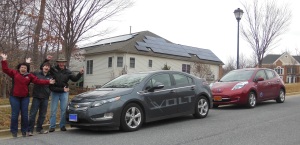Storytelling is an important part of my work as a sustainability professional. Stories inspire, move, connect, and engage. And I think the reason why is that for all the talk about what we should or need to do for the future, stories illustrate that we’re already able to and are doing the right things for our future.
Telling the energy stories of Montgomery County
 Last November, as part of an effort to illustrate all the good energy work I saw happening in Montgomery County, we started a storytelling effort. Inspired by CERT’s Energy Stories, I made a goal of publishing a new energy case study each month.
Last November, as part of an effort to illustrate all the good energy work I saw happening in Montgomery County, we started a storytelling effort. Inspired by CERT’s Energy Stories, I made a goal of publishing a new energy case study each month.
To add a little pressure, I set up the Montgomery County Energy News, a monthly e-newsletter that provides important updates about the County’s energy policies and programs, and also includes the monthly energy case study.
With the help of a writer, we’ve covered a restaurant, a homeowner’s lighting and another’s solar project, a mall’s lighting project, and even work of our County.
 In addition to the case studies, we’ve launched a series called “BENCHMARKED” which features an interview of a building owner/manager who’s benchmarked their building in ENERGY STAR Portfolio Manager – which certain buildings are mandated to do starting next year.
In addition to the case studies, we’ve launched a series called “BENCHMARKED” which features an interview of a building owner/manager who’s benchmarked their building in ENERGY STAR Portfolio Manager – which certain buildings are mandated to do starting next year.
Here we feature some companies that are leading in energy performance, our public schools and college, and (soon) our Early Bird Benchmarkers!
Storytelling is a way for us to recognize residents and businesses doing the right thing and demonstrating what our Department of Environmental Protection is trying to promote.
Storytelling also benefits these members of the Montgomery County community – especially businesses that are interested in garnering recognition for their hard work. It’s one way in which we can and like to partner with our community organizations, friends, and businesses!
“The shortest distance between two people is a story.”
– Unknown
Using Storytelling to make an issue Our-Size
In the sustainability field, so many of us are still relying on the rational argument to make our case: how many pounds of carbon we can reduce from changing our lights, how many leaves to rake to reduce phosphorus, how many miles we should bike instead of drive to improve air quality. But climate change, no matter what the numbers, is possibly too big for our brains to actually capture and comprehend (Gilbert).
So how do we take the big problem and make it real at our level? I would argue that storytelling does that. Storytelling can simultaneously convey a message, connect others to another, and also establish norms that can compel action.
Sole & Wilson (2002) identify the role of storytelling as follows:
- Share norms and values: Stories act as a medium for passing on values and creating vision.
- Develop trust and commitment: Personal stories can communicate one’s own ability and commitment, as well as conveying openness by sharing something personal. Organizational stories influence the perceived trustworthiness of the firm and its management (either positively or negatively).
- Share tacit knowledge: Enables the users to articulate tacit knowledge and communicate with feeling, which helps them convey more than they realize that they know (Weaver 2005 in Bali et al 2009).
- Facilitate unlearning: Unlearning often requires more than rational arguments. It needs an intuitive and emotional anchor, which stories can provide.
- Generate emotional connection: We connect with stories emotionally and a story that has had an impact on us will be easily recalled long into the future.
From: http://www.knowledge-management-tools.net/storytelling.html#ixzz3dX5hziIO
We’ll continue to collect our stories, slowly but surely building our library of stories to showcase all the different ways in which Montgomery County is living up to its name as a progressive, green, and sustainable County!








